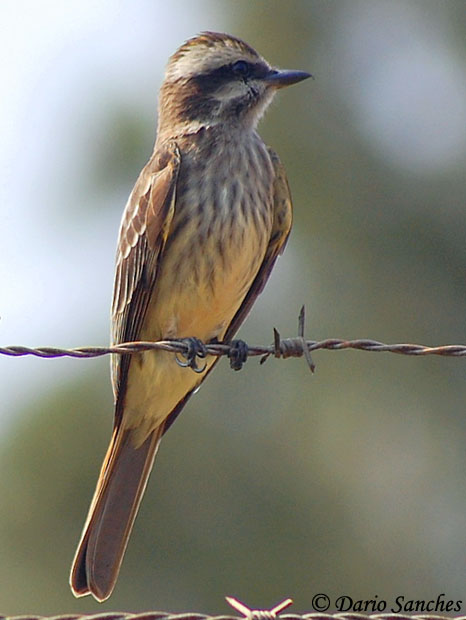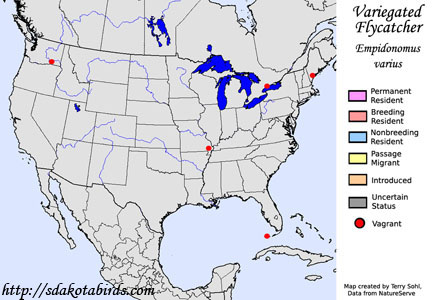| Length: 7.25 inches | Wingspan: 11.5 inches | Seasonality: Non-resident in South Dakota |
| ID Keys: Dark upperparts, pale yellow underparts, streaks on chest, strong white and dark striping on head | ||
 The
Variegated Flycatcher is a species found in South America. The first
confirmed sighting of one in North America occurred in 1977 in Maine, and
since then, strays have also shown up in Ontario, Tennessee, Florida, and
Washington state.
The
Variegated Flycatcher is a species found in South America. The first
confirmed sighting of one in North America occurred in 1977 in Maine, and
since then, strays have also shown up in Ontario, Tennessee, Florida, and
Washington state.
Habitat: Found in a variety of forested habitats, particularly along forest edges and clearings.
Diet: Feeds heavily on insects and spiders, but will also take fruits and berries.
Behavior: Forages by observing from a perch, and flying out to capture insects in mid-air.
Nesting: The nest of a Variegated Flycatcher is a cup of sticks, grasses, and bark strips, placed on the horizontal branch of a tree. The female usually lays 3 or 4 eggs, and she alone incubates the eggs.
Song: Song of a Variegated Flycatcher is a chee-chee-chooo.
Migration: Variegated Flycatchers are permanent residents in much of their South American range, but one sub-populations that breeds in southern South America is a relatively long-distance migrant, moving to northern South America outside of the breeding season.. It is assumed that vagrants in North America are from the migratory sub-populations in South America.
Interactive eBird Map: Click here to access an interactive eBird map of Variegated Flycatcher sightings
Similar Species: Unusual compared to most North American flycatchers. Most similar to the Sulphur-bellied Flycatcher, a species that can be found in western Mexico, and southern Arizona and New Mexico.
Conservation Status: Populations are found over a wide geographic range and appear to be stable. The IUCN lists the Variegated Flycatcher as a species of "Least Concern".
Further Information: 1) Audubon Guide - Variegated Flycatcher
2) BirdLife International - Variegated Flycatcher
3) First Record of Variegated Flycatcher in Western North America
Photo Information: Photo taken by Dario Sanches - Photo licensed under Creative Commons Attribution ShareAlike 2.0 Generic License.
| Click below for a higher-resolution map |
 |
| South Dakota Status: Non-resident in South Dakota |
Additional Variegated Flycatcher Photos (coming soon!!)
